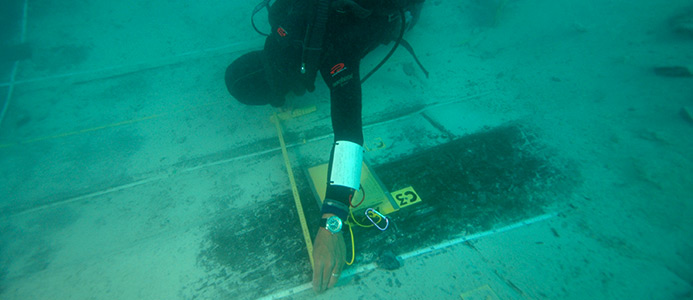In November 1619, the English ‘merchantman’ brigantine (galleon?), the Warwick, was preparing to leave Castle Harbour in Bermuda with badly needed supplies destined for the struggling Virginia colony of Jamestown. A major hurricane was threatening Bermuda, so the ship’s captain opted to remain at anchor in the harbor, hoping that the sheer limestone cliffs would mitigate some of the worst winds. The crew sealed the ship, removed her the cargo, lashed down her cannons and braced for the northwesterly winds. As the storm worsened, the ship’s anchor came loose and the vessel crashed into the reefs that lined the base of the limestone cliffs. Once her hull was breeched, the Warwick began taking on water and rolled onto her starboard side which became engulfed in silt – preserving the wood and repelling teredo (wood-eating naval shipworms), a species of saltwater clam.
The remains of the Warwick were first rediscovered and analysed in 1967 by legendary Bermudian diver Teddy Tucker and Mendel Peterson using a magnetometer. When found, it was the most complete wooden-hulled English merchantman discovered to that data. There was follow-up field work in 1979. Between 2008 and 2012, the National Museum of Bermuda, working with the Institute of Nautical Archaeology and the Center of Maritime Archaeology and Conservation at Texas A&M, excavated and documented what’s left of the Warwick.
CURRENT CONDITION
A collection of interesting artifacts from the early Warwick investigations are on display in the Shipwreck Gallery at the Bermuda Underwater Exploration Institute. The surviving structure is shedding new light on 17th-Century ship construction, life aboard an armed merchant vessel, and the early colonial history of Bermuda and America. Analysis, research and publication of the study’s findings are continuing.
STATISTICS
Location: 32°28'58.91"N, 64°42'17.64"W Length: 228 feet (69.5 meters) Capacity: 75,000 cubic feet (2124 cubic meters) Tonnage: 1,329 tons Maximum Depth: 40 feet (12.2 meters) Restricted - No Diving













